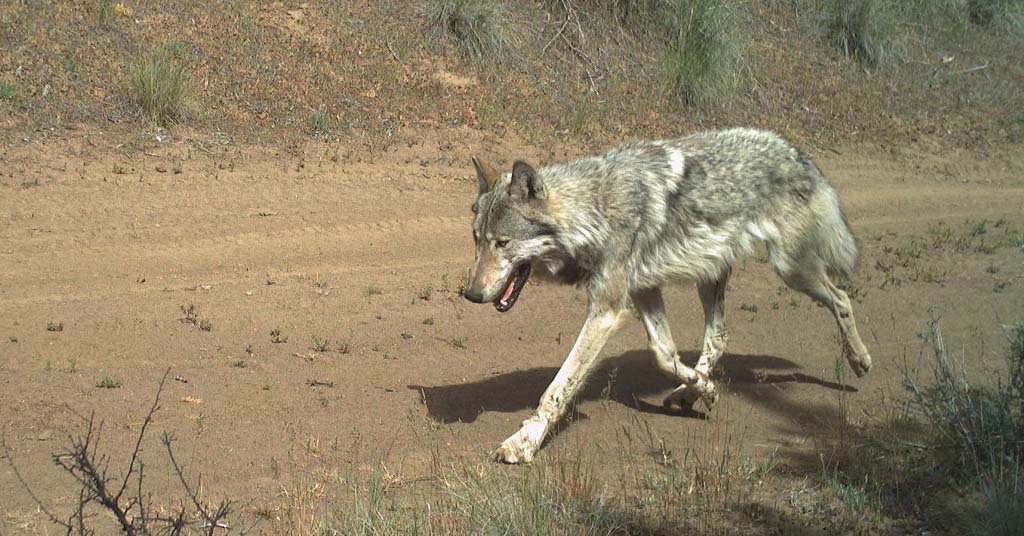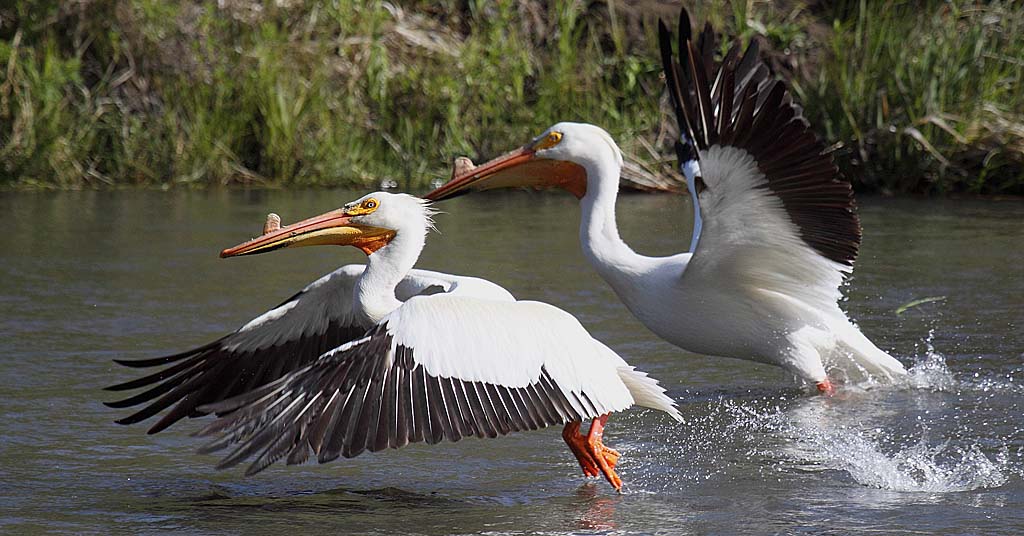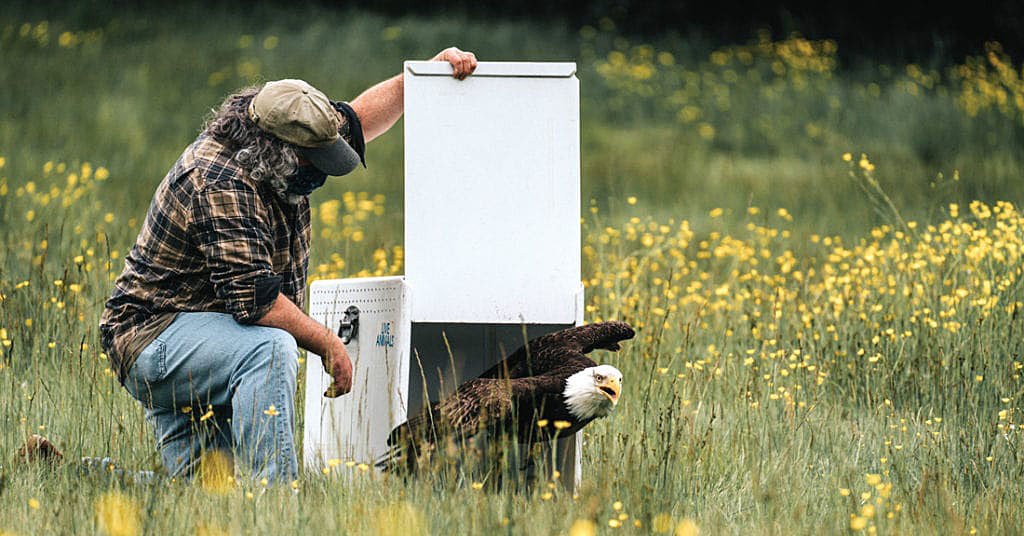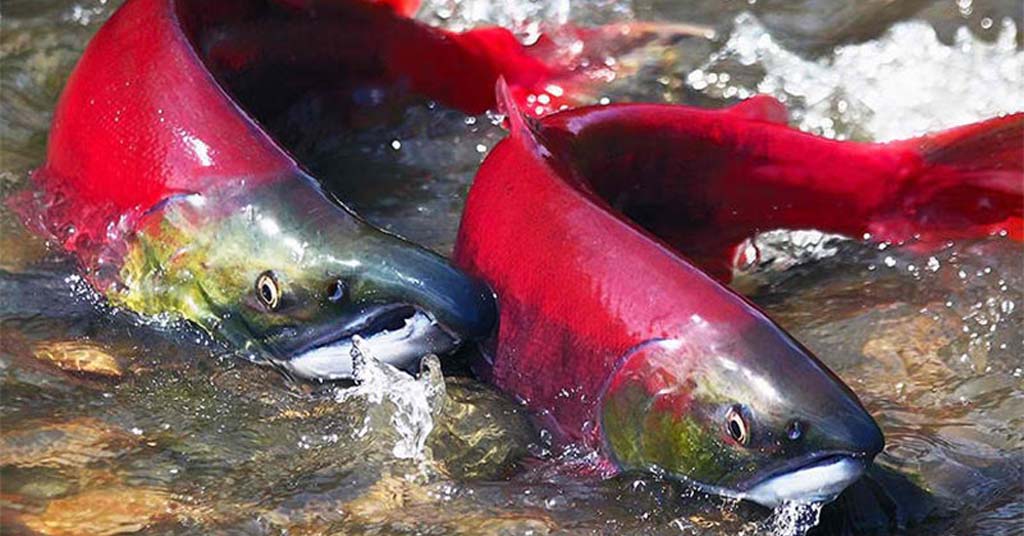ODFW employees have already killed the breeding male from eastern Oregon pack preying on cattle in Baker County

Spring exploration: In May 2021, a trail camera captured one of two yearling wolves in the Lookout Mountain Pack. Photo ODFW
By Jayson Jacoby, Baker City Herald. September 21, 2021. The Oregon Department of Fish and Wildlife has authorized killing most wolves from eastern Oregon’s Lookout Mountain Pack, including its breeding male.
But the agency does not plan to target the breeding female from the pack in eastern Baker County, which has killed six head of cattle since mid-July and injured two others, including a six-month-old calf killed earlier this month.
The permit allows ranchers to kill up to two wolves, not including the breeding pair, before Oct. 31. The permit applies to four ranchers who have lost cattle to wolves, and allows any of them to kill wolves on land they either own or legally use for grazing.
In addition, ODFW officials intend to kill four other wolves from the pack, including the pack’s breeding male, according to a press release from the agency Thursday evening, Sept. 16.
UPDATE: On Sept. 17, ODFW announced its employees had killed three wolves from the Lookout Mountain Pack, including the pack’s breeding male.
Helicopters and rifles
The pack numbers up to nine wolves, according to ODFW. Both the breeding pair and five juveniles, born this spring and now weighing about 50 pounds, have been seen by ODFW employees as recently as Sept. 8.
One or two yearling wolves, born in the spring of 2020, are likely still in the area, although ODFW workers haven’t seen either yearling since Sept. 1, according to the Sept. 16 press release.
The breeding female had a litter of at least seven pups this spring.
[perfectpullquote align=”full” bordertop=”false” cite=”” link=”” color=”” class=”” size=””]By targeting the breeding male, ODFW hopes to allow the breeding female to raise any remaining juveniles.[/perfectpullquote]
ODFW workers, firing rifles from a helicopter, killed two of those pups on Aug. 1, the day after ODFW Director Curt Melcher issued a lethal take permit for up to four subadult wolves from the pack.
Baker County Commissioner Mark Bennett had sent a letter to Melcher earlier that week asking the director to authorize the killing of some wolves.
There were no confirmed wolf attacks on cattle for more than two weeks after the two pups were killed. But since Aug. 19, Lookout Mountain wolves have killed four more calves, according to ODFW reports.
In response to the repeated attacks, Baker County Sheriff Travis Ash sent a letter to Melcher on Sept. 13 asking the state to kill the entire Lookout Mountain Pack.
Pack shifts feeding behavior
In a press release, Roblyn Brown, ODFW’s state wolf coordinator, said the agency’s initial strategy of killing subadult wolves, in an attempt to reduce the amount of food the pack needs, didn’t alter the pack’s behavior and preference for livestock as prey rather than deer and elk, which are common in the Lookout Mountain area.
“This pack has made a shift in their behavior,” Brown said. “Instead of the occasional opportunistic killing of a vulnerable calf, now they are targeting livestock despite the high numbers of elk and deer in the area where the depredations have occurred and extensive human presence to haze wolves.
“Previously we avoided removing an adult to keep the pack intact and give the breeding adults a chance to raise the remaining juveniles and to change their depredation behavior,” Brown said. “We know it’s hard for some to accept any killing of wolves let alone the juveniles, but we structured it this way to try to keep the pack intact. Unfortunately, this did not have the desired effect and we are now out of options for this pack to stop depredating on livestock.”
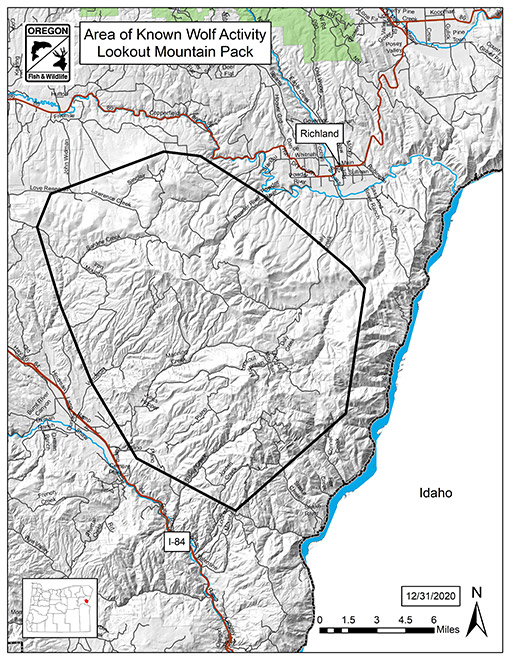
The Lookout Mountain wolf pack’s active area in eastern Oregon. Courtesy ODFW
By targeting the breeding male, ODFW hopes to allow the breeding female to raise any remaining juveniles. Reducing the number of juveniles she will need to feed increases the likelihood that some will survive, according to the agency.
There is evidence that the Lookout Mountain Pack is focused on livestock even though deer and elk are common and often seen in the same areas where depredations are occurring, according to ODFW. Wolves’ preferred prey, elk, are abundant in this unit and currently well over the population management objective set by ODFW.
‘Significant risk to livestock’
ODFW has struggled to reduce elk numbers through hunting, in part because a significant percentage of elk in the Lookout Mountain unit congregate on private land, some of which is not open to most hunters. The unit is 62% private land, a higher percentage than any of the three other units in Baker County.
According to ODFW, the Lookout Mountain Pack “presents a significant risk to livestock in the area—a risk that will continue as livestock will be present all winter. September and October also tend to have higher depredation rates historically on cattle in large rangeland pastures.”
Wolves were in the area for two years with little direct conflict with livestock, according to ODFW. The situation changed in February 2021 when wolves started visiting livestock calving pastures.
MORE: It’s a trap! Politics, science collide as Idaho wolf law takes effect
Ranchers increased night checks, installed fladry (a type of fencing designed to deter wolves) and hazed wolves from near their calving and winter pastures, but depredations began in mid-July and have continued.
Ranchers have repeatedly shot at wolves chasing their livestock, which is allowed under Oregon’s “caught in the act” statute, but missed, according to ODFW.
ODFW staff have spent over 120 hours on the ground in the Lookout Mountain area since July 30 to try to remove the yearlings and supplement human presence efforts to move wolves away from livestock. Livestock producers have spent hundreds more hours, according to ODFW.
There is no evidence that the wolves are being attracted to pastures or other areas with livestock due to bone piles, carcasses or other circumstances, according to ODFW. Agency workers have not identified any conditions that attract wolves and fosters conflict during its repeated investigations of depredation incidents.
MORE: Has this range rider figured out the key to wolf management?
Brown thanked ranchers for their efforts to try to deter wolves.
“While nine depredations in relationship to the large number of cattle raised in Oregon might seem like not that big of a deal, this situation has had a huge impact on the individual producers affected,” Brown said. “Local producers have worked so hard to protect their calves for months now, going above and beyond what they were required to do under Oregon’s Wolf Plan at great personal cost in time, energy, fuel and other expenses.”
Columbia Insight is publishing this story as part of the AP StoryShare program, which allows newsrooms and publishing partners to republish each other’s stories and photos.




